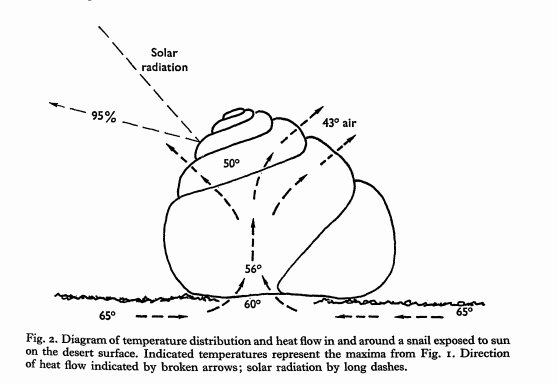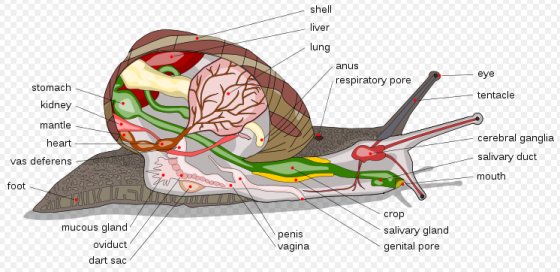Whilst researching some applications of the laws of thermodynamics to the biochemical processes in living things, I came across some very intriguing facts about snails.
Living things react to changes of heat in the environment in two broad ways: through thermoregulation or through thermoconformity. Thermoconformers are constrained to follow the temperature of their immediate environments. Thermoregulators adjust their temperatures within a range which may lie within, or overlap, the environmental temperature range.
It is fairly widely known that animals control their temperatures in various ways. The panting of dogs is widely known. Not so well known is the panting of snails.
Reptiles were once thought to be thermoconformers. Cowles and Bogert's paper on thermal tolerance (R.B. Cowles and C.M. Bogert. 1944. Bull. Am. Mus. Nat. Hist. 83: 261–296) showed that reptiles are thermoregulators. Cowles and Bogert appear to be the first to use the concept of Critical Thermal Maximum - CTM - as a measure of the upper limit of the environmental temperature range which a living thing can tolerate.
Thermoregulation in snails.
In the paper DESERT SNAILS: PROBLEMS OF HEAT, WATER AND FOOD, by Knut Schmidt-Nielson, C.R. Taylor and Amiram Shkolnik, the introduction states:
It will be a surprise to many biologists that snails are found in large numbers on the dry, barren surfaces of certain hot deserts. The present study is concerned with one such snail, Sphinterochila boissieri, which occurs in the deserts of the near east. Live specimens of this snail, withdrawn in the shell and dormant, can be found on the desert surface in mid-summer, fully exposed to sun and heat. The surface temperature of these deserts may reach 70oC and more than a year may pass between rains. Such a severe habitat poses three seemingly insurmountable problems for these snails: (1) thermal death, (2) dessication, and (3) death from starvation. ...
Sphincterochila_boissieri is a fairly small land snail with an average weight of about 4 grams. The study cited above recorded lethal temperature, weight loss, water loss and oxygen consumption. From some very clever experimentation the authors answered many questions about the processes of thermoregulation in Sphinterochila boissieri.
Disturbed snails and water loss
One question was not answered by the authors: why do snails increase their water loss when disturbed. Here is the relevant quote from the report:
It has previously been established that even minor disturbances of a dormant snail, such as a slight knock, increase its water loss ()Machin, 1965. We therefore discontinued daily weighings and left the snails completely undisturbed for longer periods of time. The average daily weight loss now decreased ...The authors investigated the methods used by a snail to control its temperature and to conserve water. They found that the snail seals itself inside the shell with an epiphragm, and withdraws into the upper part of the shell. The shell rests on the desert with only a few points of contact, reducing conductance. The major air space under the snail also reduces conductance. The shell is highly reflective. All things considered, the snail has a better design of desert house than many humans.
These results confirm Machin's observation that even moderate disturbance increases the water loss from a dormant and seemingly completely inactive snail ...

As a part of their investigations the authors noted that "if a snail dies or is killed within the shell with the epiphragm intact, the rate of evaporation increases tenfold or more."
Snail anatomy

Source: Wikipedia, GNU free documentation licence version 1.2
Snails have a seemingly rudimentary nervous system. However, it is sufficiently complex to allow a form of learned behaviour - operant conditioning. A study1 has shown that a snail's respiratory behaviour can be conditioned. A study2 on slugs shows that the pneumostome rhythm - I would call it a mark-space rhythm - changes with temperature. Snails breathe. In a rather lax use of the English language, when temperatures rise, a snail can be said to pant. Tactile stimulation in the pneumostome area provokes a closure reflex.
Discussion:
I suggest that the death of a withdrawn snail may cause its mantle to relax into an open state. Water loss would then occur rapidly through the foot area.
I further suggest that disturbance of a dormant snail will cause a reflex action. Either the foot or the pneumostome may be exposed briefly in a form of panic reaction. Again, whilst the pneumostome has been observed to close in response to direct tactile stimulation that should not be taken as conclusive of a like reaction to a motion or shock stress to the snail in its dormant state. The possibility should be considered that the pneumostome rhythm may be adversely affected by a snail's reflex reaction to being disturbed.
An investigation is needed in which the reaction of a snail to disturbance may be directly observed inside its shell, either by probing the relevant neurons, by using a microscopic camera or by cementing transparent windows over holes in the shell.
------------------------------------------------------------------------------------------
References:
[1] - http://www.sciencedirect.com/science?_ob=ArticleURL&_udi=B6WNM-4FV41XD-1...
[2] - http://www.ncbi.nlm.nih.gov/pubmed/2899479?dopt=Abstract





Comments